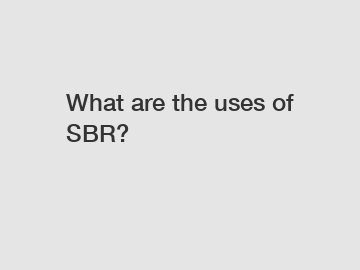What are the uses of SBR?
Uses of SBR.
SBR, or styrene-butadiene rubber, is a versatile synthetic rubber that finds a wide range of applications across various industries. In this article, we will delve into the uses of SBR, exploring its origin, how its uses have been proven, and its significance and impact.
Origin and Production Process.

Styrene-butadiene rubber, commonly known as SBR, is a synthetic elastomer produced by the copolymerization of styrene and butadiene. The process involves the polymerization of these two monomers in the presence of an initiator, typically a free radical initiator like benzoyl peroxide.
The resulting polymer has excellent resistance to abrasion and aging, making it suitable for various applications. SBR can be produced in different forms, including emulsion-polymerized SBR (E-SBR) and solution-polymerized SBR (S-SBR). Both forms have distinct properties that make them suitable for specific uses.
Uses of SBR.
1. Tire Industry: One of the most significant uses of SBR is in the manufacturing of tires. SBR's high abrasion resistance and excellent traction properties make it an ideal material for tire treads. It improves the tire's grip on the road, enhancing safety and reducing the risk of skidding. Additionally, SBR's excellent wear resistance ensures the durability and longevity of the tire.
2. Footwear: SBR's properties, such as flexibility, resilience, and water resistance, make it a popular choice in the footwear industry. It is commonly used in shoe soles, providing comfort, shock absorption, and resistance to wear and tear. SBR's ability to withstand different environmental conditions, such as wet surfaces, makes it particularly suitable for sports shoes and outdoor footwear.
3. Adhesives and Sealants: SBR is often used as a binder in adhesives and sealants. Its ability to form strong bonds with various substrates, such as wood, metal, and plastics, makes it an excellent choice for bonding applications. SBR-based adhesives and sealants are widely used in construction, automotive, and packaging industries due to their high strength, flexibility, and resistance to temperature variations.
4. Conveyor Belts: SBR's exceptional tensile strength, tear resistance, and abrasion resistance make it an ideal material for conveyor belts. These belts are used in industries such as mining, agriculture, and manufacturing to transport materials efficiently. SBR-based conveyor belts can withstand heavy loads, continuous movement, and exposure to various chemicals and temperatures, ensuring reliable and durable performance.
Significance and Impact.
The diverse uses of SBR highlight its significance in many industries. Its unique properties such as abrasion resistance, flexibility, water resistance, and bonding capability make it a versatile material for various applications. SBR's contributions to the tire industry have improved road safety and reduced accidents caused by poor traction. In the footwear industry, SBR enhances the comfort and durability of shoes, providing long-lasting performance. The use of SBR in adhesives and sealants has led to stronger and more reliable bonds in construction and manufacturing projects. Additionally, SBR-based conveyor belts have revolutionized material transportation in various industries, improving efficiency and productivity.
In conclusion, SBR's applications are widespread and serve critical functions in various sectors. Its unique combination of properties makes it a preferred choice for tire manufacturing, footwear production, adhesive bonding, and conveyor belt fabrication. The ongoing research and development in the field of SBR aim to further enhance its properties and explore new applications, ensuring its continued significance and impact in the future.
For more information, please visit acrylic emulsion for paper coating, The Difference Between Nitrile Rubber and NBR Latex, sb latex.



Comments
0